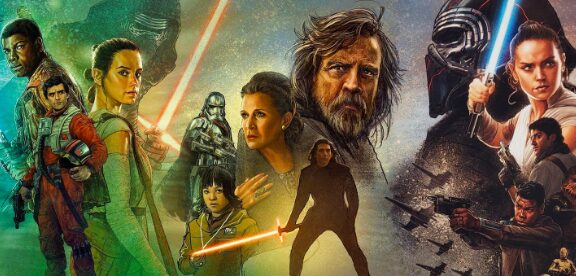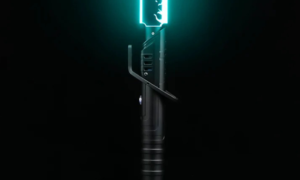The Star Wars Sequel Trilogy brought a new era to the galaxy far, far away. Disney’s acquisition of Lucasfilm in 2012 represented a daring step to extend the narrative following Return of the Jedi. With The Force Awakens released in 2015, The Last Jedi in 2017, and The Rise of Skywalker in 2019, the trilogy introduced fresh characters, themes, and viewpoints while respecting the originals.
It would not be wrong to say that The Sequel Trilogy was a reinterpretation! Because it merged sentimentality with creativity to transform the saga for a different generation.
1. Fresh Heroes and Villains
The trilogy brought forth new main characters. Rey, a junk dealer from Jakku, emerges as the main character. Her path as a hero attuned to the Force and shrouded in mystery struck a chord with viewers. Rey’s bond with the Force and her lightsaber duels reflected Luke Skywalker’s journey in the original trilogy.
Kylo Ren appeared as a tormented antagonist. The son of Han Solo and Leia grappled with the forces of light and darkness. His distinctive crossguard lightsaber and unpredictable behavior distinguish him from Darth Vader.
Additional new characters were Finn, a former stormtrooper who decided to oppose the First Order, and Poe Dameron, a bold pilot in the Resistance. Collectively, they added variety and richness to the Star Wars storyline.
2. Bridging Generations with Legacy Characters
The Sequel Trilogy reintroduced cherished characters. Han Solo, Leia Organa, and Luke Skywalker returned to guide new champions. These iconic figures handed over the baton while facing their own challenges.
Han’s heartbreaking demise in The Force Awakens surprised fans. Leia’s role as a general showcased her lasting strength. Luke’s journey in The Last Jedi, in which he grappled with failure and the possibility of redemption, enriched his character’s complexity.
These ties to the original trilogy intensified the emotional stakes. The recognizable characters prompted fans to recall the saga’s origins while advancing the narrative.
3. Revisiting Core Themes
The Sequel Trilogy revisited important themes of Star Wars. Hope, redemption, and the equilibrium of the Force continued to be key elements of the narrative.
Rey’s path mirrored Luke’s in numerous aspects. Her ascent from anonymity to being a Jedi represented hope for the galaxy. Kylo Ren’s redemption in The Rise of Skywalker reflected Anakin Skywalker’s resurgence to the light.
The trilogy additionally investigated fresh concepts. It emphasized the influence of choice, illustrating how characters such as Finn and Rey shaped their own destinies. By interlacing classic and contemporary elements, the trilogy remained faithful to the essence of Star Wars.
4. Expanding the Galaxy
The Sequel Trilogy brought forth breathtaking new settings. The arid deserts of Jakku, the secluded islands of Ahch-To, and Crait’s shining salt flats broadened the Star Wars universe. These environments provided the galaxy with a new vibe while respecting legendary planets such as Tatooine and Hoth.
New factions and stories also surfaced. The First Order emerged from the remnants of the Empire, introducing a fresh wave of stormtroopers and TIE fighters. The Resistance mirrored the Rebel Alliance but encountered even tougher challenges.
The series enriched the galaxy’s backstory. The enigmatic map leading to Luke Skywalker and the age-old Jedi writings on Ahch-To enriched the mythology of the Force.
5. Bold Storytelling Choices
The series embraced challenges. The Last Jedi was particularly daring, overturning expectations and questioning conventional Star Wars themes. Luke’s hesitation to train Rey and his ultimate sacrifice ignited discussion among fans.
The concept that anyone, not solely those of noble lineage, could use the Force was presented in The Last Jedi. Rey’s beginnings as “no one” initially diverged from the Skywalker bloodline.
Although The Rise of Skywalker ultimately unveiled Rey’s identity as a Palpatine, the trilogy maintained that a legacy does not determine one’s fate.
6. Passing the Torch to New Fans
The Sequel Trilogy sought to motivate a fresh generation of enthusiasts. Rey’s narrative, along with varied characters such as Finn and Rose, expanded the allure of Star Wars.
Young audiences identified with these heroes, just as the viewers of the original trilogy related to Luke and Leia. The trilogy updated Star Wars for a contemporary audience, ensuring it remains relevant and accessible.
7. The Controversy and Its Legacy
The Sequel Trilogy was not free from controversy. Supporters discussed issues such as Luke’s portrayal, Rey’s lineage, and the tempo of The Rise of Skywalker.
Despite the differences, the trilogy managed to rekindle worldwide enthusiasm for Star Wars. It brought forth new heroes, exciting lightsaber duels, and unforgettable moments that will last for years.
A Saga Reimagined
The Sequel Trilogy reinvented Star Wars for a fresh audience while respecting its history. By mixing traditional and modern components, it crafted a narrative that connected with audiences of every age.
The trilogy’s daring decisions, new characters, and grand lightsaber battles demonstrate that Star Wars continues to be an enduring story of hope, redemption, and adventure.
As we gaze toward the future of Star Wars, the Sequel Trilogy serves as a testament that the saga will consistently discover ways to inspire fresh audiences. May the Force accompany you!
Image Source: playground.ru



































